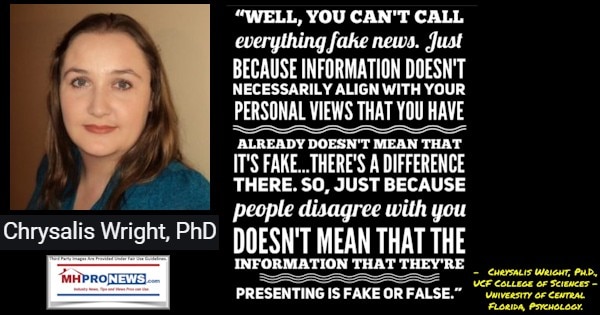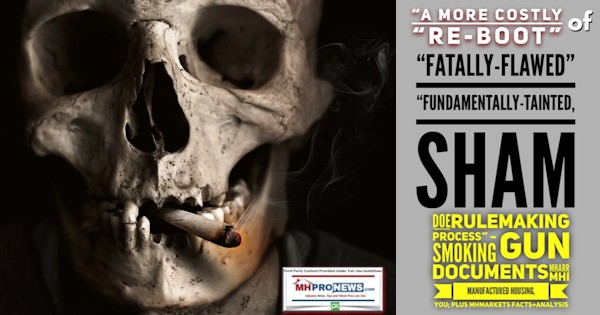
In considering the press release and the following pull quote, ponder the smoking gun document obtained yesterday by MHProNews from DOE. Then think about the Iron Triangle, how that Iron Triangle has played out in manufactured housing, and then John Kenneth Galbraith’s quote to tee up this from the release below. “In part, MHARR’s comments stress that DOE’s August 26, 2021 proposed rule is, in reality, nothing more than a more costly “re-boot” of the Department’s fatally-flawed June 2016 manufactured housing proposed “energy” rule, developed through a fundamentally-tainted, sham DOE “negotiated rulemaking” process, featuring undisclosed leaks of information and documents, as well as undisclosed coordination between DOE, energy special interests and DOE-favored allies.”
Too many in our profession are still unaware of the ‘kill shot’ this regulation represents to numbers, nor of the apparent duplicity of the Manufactured Housing Institute in this DOE process, as is revealed by the document obtained from DOE from MHI, and is unpacked in the exclusive report and analysis below.
It is worth wondering if MHARR has obtained those same documents about MHI that are referenced and revealed in the article above? Against that backdrop, here is the MHARR press release followed by the related comments letter, and some additional linked information. That will be followed by our business daily market reports, and left-right headline snapshots.

OCTOBER 14, 2021
TO: MANUFACTURED HOUSING INDUSTRY PRODUCERS,
RETAILERS AND COMMUNITIES
FROM: MARK WEISS
RE: MHARR SUBMITS THIRD COMMENTS ON PROPOSED
DOE MANUFACTURED HOUSING ENERGY STANDARDS
Attached, for your information, are further comments filed by the Manufactured Housing Association for Regulatory (MHARR) on October 13, 2021 in connection with the federal Manufactured Housing Consensus Committee’s (MHCC) ongoing consideration of proposed manufactured housing “energy conservation” standards published by the U.S. Department of Energy (DOE) on August 26, 2021. The MHCC has already held two day-long conference call meetings to review the DOE proposed rule and will continue its analysis of the August 26, 2021 DOE proposal at a third meeting currently scheduled for October 20, 2021. The attached comments are being submitted in connection with this third MHCC meeting. At present, the deadline for the submission of written comments to DOE on the proposed rule is October 25, 2021, although MHARR has filed a request for an extension of the comment deadline to December 27, 2021, due to the multi-faceted technical and cost issues raised by these new and unprecedented proposed standards.
MHARR’s October 13, 2021 comments address two principal issues: (1) the pervasive overlap between the August 26, 2021 DOE proposed standards and DOE’s thoroughly discredited 2016 proposed manufactured housing energy standards, derived from a fundamentally-tainted DOE “negotiated rulemaking” process; and (2) the fundamentally arbitrary and capricious nature of the 2021 proposed rule and its various provisions, in violation of applicable federal law.
In part, MHARR’s comments stress that DOE’s August 26, 2021 proposed rule is, in reality, nothing more than a more costly “re-boot” of the Department’s fatally-flawed June 2016 manufactured housing proposed “energy” rule, developed through a fundamentally-tainted, sham DOE “negotiated rulemaking” process, featuring undisclosed leaks of information and documents, as well as undisclosed coordination between DOE, energy special interests and DOE-favored allies.
MHARR’s third comments also address the fundamentally arbitrary and capricious nature of DOE’s futile effort to convert the 2021 IECC – a code developed for site-built homes by state and local building code officials – into something that it manifestly is not, i.e., a national code for affordable manufactured homes. This includes fundamental discrimination within the proposed rule against certain manufactured homes and manufactured home purchasers, based on criteria and thresholds that are not to be found in, defined by, or authorized by relevant law.
Again, MHARR cannot overstate the destructive and fundamentally-discriminatory nature of these unnecessary and unnecessarily-costly proposed regulations, which cannot and must not be taken too lightly by industry members. Accordingly, MHARR urges all industry members to submit comments to DOE to oppose these proposed standards, which violate existing federal law, will severely undermine the purchase affordability of manufactured homes, and exclude millions of lower and moderate-income Americans from the mainstream HUD Code manufactured housing market and homeownership altogether. To facilitate such participation, MHARR will make its DOE comments available to the entire industry in advance of current (or possibly extended) DOE deadline.
Attachment
##
MHProNews Note: that attachment is as shown below.

October 13, 2021
VIA FEDERAL EXPRESS AND ELECTRONIC SUBMISSION
Manufactured Housing Consensus Committee
C/O Home Innovation Research Labs
Administering Organization
400 Prince George’s Boulevard
Upper Marlboro, Maryland 20774
Re: Energy Conservation Standards for Manufactured Housing – Third Comments
Dear Members of the Manufactured Housing Consensus Committee:
The Manufactured Housing Association for Regulatory Reform (MHARR) submits the following third set of comments in connection with the Manufactured Housing Consensus Committee’s (MHCC) consideration of a Supplemental Notice of Proposed Rulemaking (SNPR) regarding “Energy Conservation Standards for Manufactured Housing” published by the U.S. Department of Energy (DOE) in the Federal Register on August 26, 2021.[1] MHARR is a national trade association representing producers of manufactured housing subject to regulation pursuant to the National Manufactured Housing Construction and Safety Standards Act of 1974 (1974 Act), as amended by the Manufactured Housing Improvement Act of 2000 (2000 reform law), as well as relevant provisions of the Energy Independence and Security Act of 2007 (EISA).
I. INTRODUCTION
The following are MHARR’s third set of comments regarding MHCC consideration of DOE’s August 26, 2021 manufactured housing energy standards supplemental proposed rule. MHARR’s initial comments, submitted September 15, 2021, principally addressed policy issues related to the proposed standard, including its predictably destructive cost impact on manufactured housing consumers, the manufactured housing market and the manufactured housing industry, as well as the absence of any genuine or legitimate need for excessive and discriminatory manufactured housing energy standards, based on federal data showing that manufactured housing residents already pay less for all types of home energy sources than residents of detached, single-family homes under existing HUD standards. In its second set of comments, filed October 1, 2021, MHARR provided additional information concerning the fundamental incompatibility of the International Energy Conservation Code (IECC) with manufactured housing construction and affordability, the fundamental incompatibility of the IECC with the objectives and consensus procedures of the Manufactured Housing Improvement Act of 2000, and an initial statement of specific DOE proposed standards that would be inappropriate, non-cost-effective for manufactured housing, or otherwise destructive of manufactured housing and the manufactured housing market.
In this third set of MHCC comments, submitted in connection with the MHCC’s scheduled meeting on October 20, 2021, MHARR addresses: (1) the substantial overlap (although denied by DOE) between the current proposed 2021 DOE manufactured housing energy standards and the thoroughly discredited manufactured housing energy standards proposed by DOE in June 2016 based on a deceitful and manipulated “negotiated rulemaking” process (subsequently rejected by the Office of Management and Budget in 2017); and (2) the fundamentally arbitrary and capricious nature of the DOE SNPR proposal, based on an unlawfully vague, ambiguous and undefined delegation of rulemaking power under section 413 of the Energy Independence and Security Act of 2007.[2]
For the reasons set forth in all of these comments, the August 26, 2021 proposed DOE manufactured housing energy standards rule should be rejected by the MHCC with relevant comments submitted to DOE, together with a request for an extension of the current October 25, 2021 comment deadline, in order to ensure a complete and thorough review of the DOE proposal, and proper stakeholder input.
II. COMMENTS
A. THE PROPOSED STANDARDS ARE A DECEPTIVE
“REBOOT” OF DOE’S TAINTED 2016 STANDARDS
DOE, in its August 26, 2021 Supplemental Notice of Proposed Rulemaking (SNPR), repeatedly maintains that its “new” proposed “energy conservation” standards for manufactured homes are substantively different from the disastrously-flawed standards proposed in its original June 2016 Notice of Proposed Rulemaking,[3] and that the alleged “changes” incorporated in the 2021 proposed standards somehow address or mitigate the cost concerns and other fundamental flaws highlighted by MHARR and other commenters in the 2016 rulemaking. For example, DOE states in its August 26, 2021 SNPR, that its so-called “tiered” standards proposal, based on the 2021 version of the International Conservation Code (IECC), would specifically “replace DOE’s June 2016 proposal.”[4]Similarly, DOE asserts that this “tiered” proposal responds to “concerns raised by HUD” and others with respect to the 2016 proposed rule and the need to maintain the purchase price affordability of federally-regulated manufactured housing.[5] The reality, however, is that the 2021 DOE proposed rule is nothing more than a thinly-veiled “reboot” of the fatally-flawed and defective 2016 proposed rule – made substantively worse by the more stringent incorporated mandates of the 2021 IECC. Its putative “tiered” structure, moreover, is little more than window-dressing designed to provide a superficial veneer of supposed cost-sensitivity, while leaving DOE completely free to adopt the more costly “Tier 2” standards across-the-board in a final rule. This duplicitous bait-and-switch scheme should be rejected by the MHCC
At the outset, DOE’s assertion that the 2021 proposed standards somehow “replace” the 2016 proposed standards in any substantive way – other than to make them even more stringent and costly – is demonstrably false.
While DOE, very early in its 94-page August 26, 2021 proposed rule,[6] states that its current proposal “replaces” the fatally-defective June 2016 proposed manufactured housing energy standards that were rejected by the Office of Management and Budget (OMB) and ultimately withdrawn from further consideration by the Trump Administration,[7] it acknowledges much later in its SNPR,[8] that the DOE 2021 proposal, instead, merely “updat[es] the proposed energy conservation standards presented in the June 2016 NOPR.”[9](Emphasis added). While the term “replace,” therefore, deceptively implies the substitution of a completely new proposal for the rejected and withdrawn 2016 proposed rule, the reality is that the 2021 proposed rule is simply a warmed-over – and even more stringent and costly version of DOE’s baseless 2016 proposed standards, due to the 2021 proposal’s reliance on the much more stringent and costly 2021 IECC, which, according to the International Code Council (ICC) is only 10% below net-zero energy usage for residential buildings.[10] The DOE-alleged “replacement” of the previously rejected and withdrawn 2016 DOE proposal, consequently, is a sham — in at least two primary respects – as is explained in greater detail below. This deceptive proposal would not ameliorate the worst impacts of high-cost DOE energy regulation or protect lower and moderate-income manufactured housing consumers from those destructive impacts, up to and including total exclusion from the manufactured housing market and homeownership more broadly. Rather, the 2021 DOE proposal is a dressed-up retrenchment of the 2016 proposed rule “on steroids,” due to its reliance on the more stringent and — as alleged by the National Association of Home Builders (NAHB) and others – politically manipulated 2021 IECC.[11]
The full scope of the deception inherent in the 2021 SNPR becomes evident only through a thorough and complete review of its entire 94 pages, within the context of the entire administrative record of the present rulemaking. Such a review demonstrates two key facts.
First, the “two-tiered” approach set forth as DOE’s “primary” proposal in the 2021 SNPR, is not binding on DOE with respect to any final rule in this proceeding. Put differently, it is entirely possible, if not likely, that a DOE final rule in this proceeding would impose the so-called “Tier 2” standards (or some variant thereof) on all manufactured homes, regardless of price.[12] Among other things, this is demonstrated by the fact that while the two-tiered regulatory approach is deemed “primary” in DOE’s August 26, 2021 SNPR, and a “one-size-fits-all,” one-tier approach is identified as an “alternate” methodology in that SNPR, the two approaches were presented in a completely opposite configuration just weeks earlier, in DOE’s July 7, 2021 “Notice of Intent to Prepare an Environmental Impact Statement for Energy Conservation Standards for Manufactured Housing.”[13]In that statutorily-required document,[14]DOE referred to a single, across-the-board energy conservation standard for manufactured homes “based on the 2021 IECC” as its primary “proposed action,” with a “tiered approach” being “consider[ed]” only as “an action alternative.”[15] (Emphasis added). Having published both proposals (i.e., “tiered” and “un-tiered”) in the Federal Register, DOE could attempt to adopt a full-scale, un-tiered, IECC 2021-based standard for all manufactured homes, regardless of price, as its final rule. The MHCC should not accept or endorse such a “bait-and-switch” scenario.
Second, any claim that the 2021 proposed standards are somehow “different” from, less stringent than, or more cost-sensitive than the fatally-flawed 2016 proposed standards is, again, demonstrably false. While DOE does, in fact, attempt to portray the 2021 proposed standards as being more cost-sensitive than the 2016 proposed rule,[16]a close review of the 2021 SNPR shows that contention to be baseless and deceptive. In the 2021 SNPR’s 23-page summary and explanation of the 2021 proposed standards,[17]DOE states 30 times that various elements of its August 26, 2021 SNPR proposal are either “consistent with,” “based on” or “remain the same” as either the 2016 “negotiated rulemaking,” the Manufactured Housing Working Group’s (MHWG) 2015/2016 recommendations, or the 2016 proposed rule, or some combination of the three.[18]Further, of the 24 separate components addressed in SNPR Tables III-13 and Table III-14 concerning “insulation installation” and “air barrier” criteria,[19]DOE proposes “no change” between the 2016 IECC and 2021 IECC levels for 11 components and proposes updating the applicable criteria for 5 more to 2021 IECC levels. By contrast, it proposes eliminating or excluding just 4 of those 24 components.[20]Again, therefore, the fundamental thrust of the 2021 DOE proposal is not to materially ameliorate the destructive cost impacts of the 2021 IECC, or its original 2016 proposed rule, but to use the 2021 IECC to bootstrap its original 2016 IECC-based proposals and add a significant number of even more stringent and costly measures that would needlessly undermine the affordability of manufactured homes as mandated by preexisting federal law.
Again, the MHCC should not sanction or endorse such a flagrant “bait and switch” stratagem, and should, instead, reject the DOE 2021 SNPR proposal in its entirety.
B. DOE’S ENTIRE PROPOSAL IS ARBITRARY, CAPRICIOUS
AND AN ABUSE OF DISCRETION IN VIOLATION OF LAW
The federal Administrative Procedure Act (APA) provides for the invalidation of agency action that is determined to be “arbitrary, capricious, an abuse of discretion, or otherwise not in accordance with law.”[21]To satisfy this statutory standard, an agency “must examine the relevant data and articulate a satisfactory explanation for its action including a rational connection between the facts found and the choice made.” Burlington Truck Lines v. United States, 371 U.S. 156, 168, 83 S.Ct. 239, 245-246, 9 L.Ed.2d 207 (1962).
In order to provide a complete and fully-articulated administrative record for a reviewing court in any possible legal challenge to DOE’s final rule in this matter,[22] the MHCC should identify, consider and expressly reject the various ways that DOE, in its SNPR, has arbitrarily and subjectively altered, modified, or transformed the application of the 2021 IECC, due to the fact – specifically acknowledged by DOE – that the IECC is not a code established or designed for manufactured homes as defined by federal manufactured housing law.[23]Put differently, DOE’s August 26, 2021 proposed rule relies on an inconsistent jumble of arbitrary thresholds, modifications, alterations, and outright fabrications, concocted by DOE in a futile effort to convert the 2021 IECC from a code not designed, intended, or appropriate for manufactured housing, into something that it is not – a legitimate, cost-effective energy standard for the unique nature and construction of HUD-regulated manufactured housing. The MHCC should not accept or endorse, even implicitly, this phony exercise that will decimate the manufactured housing market and place homeownership beyond the means of millions of Americans who would otherwise be able to afford a modern HUD-regulated manufactured home.
Significantly, DOE does not deny that it has exercised “broad” (and, in fact, overbroad) discretion in its August 26, 2021 SNPR, to alter, modify and/or eliminate certain elements of the 2021 IECC and its application, in a subjective and arbitrary effort to unilaterally convert the IECC from a code for more costly, larger and differently-designed, constructed and configured site-built homes, into a code for federally-regulated manufactured homes. DOE thus states in its SNPR:
“Because the IECC is specific to site-built structures, DOE’s supplemental proposal, while based on the 2021 IECC, has required modifications to the IECC provisions for application to manufactured homes. In DOE’s view, the language Congress used in instructing DOE to set standards for these structures is broad and does not require the imposition of requirements for manufactured homes that are identical to those that the IECC provides for site-built structures. The use of the phrase ‘based on’ readily indicates that Congress anticipated that DOE would use its discretion in adapting elements of the IECC’s provisions for manufactured housing use, including whether those elements would be appropriate in light of the specific circumstances related to the structure.”[24]
(Emphasis added). While MHARR agrees that the statutory directive of 42 U.S.C. 17071 does not require the imposition of energy standards for manufactured homes that “are identical to those that the IECC provides for site-built structures,”[25]the reality is that the statute provides no specific benchmarks, standards, principles, or criteria whatsoever, for the necessary conversion of the IECC from a site-built-only code into a code for non-site-built manufactured housing, and DOE has articulated no such overriding criteria in its August 26, 2021 SNPR.
Indeed, there is no evidence that Congress, at the time of its adoption of the Energy Independence and Security Act of 2007 – and EISA’s section 413 manufactured housing energy directive — was even aware that the IECC is (and continues to be) designed solely for site-built housing, is not an appropriate or cost-effective code for manufactured housing, and is voted-on, in its final form, exclusively by state and local building code officials with no direct responsibility for the regulation of manufactured housing construction or safety. Further, there is no evidence and no indication from the statutory text of EISA section 413, that Congress intended to confer upon DOE – an agency with no other comparable regulatory role regarding housing or residential construction — unlimited, undefined and unrestrained discretion to alter aspects of the IECC, or its application, based on its own unilateral decisions.[26] Nevertheless, the August 26, 2021 SNPR contains multiple modifications and alterations to the 2021 IECC and its application.
As an initial matter, DOE attempts to “limit” the predictably devastating purchase price and manufactured housing market impacts of the 2021 IECC by applying a highly-modified and, supposedly, limited version of the IECC standards to manufactured homes with a manufacturer’s “retail list price” of $55,000 or less.[27] These modified standards, according to DOE, will result in a purchase price increase of no more than $750.00 for homes within “Tier 1” of DOE’s two-tiered, “primary” proposal.[28] Virtually every aspect of this proposal, however, is fundamentally arbitrary in violation of the APA.
First, there is no express or implied authorization in EISA section 413 for a multi-tiered regulatory regime. Clearly, if Congress had wanted a multi-tiered regulatory system, or wished to authorize a multi-tiered regulatory system that would effectively discriminate against certain purchasers or subcategories of manufactured homes[29] – all of which are expressly identified and protected as “affordable” homes under federal manufactured housing law – it could have done so, but manifestly, did not.
Second, there is nothing express or implied in EISA section 413 to authorize a two-tiered or multi-tiered energy regulatory structure based specifically on a manufacturer’s retail list price, in violation of pre-existing federal law, which identifies and was designed specifically by Congress to protect the purchase price affordability of all manufactured homes as a major source of affordable homeownership for all Americans.[30]Moreover, using this particular parameter as the demarcation line between the extreme “Tier 1” proposed standards and the even more extreme “Tier 2” standards is fundamentally arbitrary, in violation of the APA because, as DOE admits in its August 26, 2021 SNPR, the manufacturer’s retail list price is not the same as the retail purchase price of the home to the consumer, and does not necessarily correspond directly or closely with that final acquisition price.[31]
Third, there is nothing express or implied in EISA section 413 to authorize a manufacturer’s retail list price demarcation line of $55,000 to separate so-called “Tier 1” energy standards from so-called “Tier 2” energy standards. And, indeed, this demarcation or “boundary” as characterized by DOE,[32] is arbitrary and capricious – in itself – in multiple respects. As an initial matter, DOE’s unilateral creation of a multi-tiered standard, in itself, is arbitrary, as noted above. Further, the selection of the manufacturer’s “retail list price” as the metric for the demarcation line, is arbitrary. As DOE itself notes, the manufacturer’s retail list price is not synonymous with or equal to the final acquisition price paid by the home purchaser. As DOE thus acknowledges, “the manufacturer’s retail list price and the purchase price are not the same.”[33] Indeed, the demarcation price selected by DOE as the threshold between its proposed “Tier 1 and “Tier 2” standards: (1) bears no relation to the price paid by the ultimate purchaser of the home; (2) bears no relation to the ability of that consumer to qualify for financing to purchase the home at that price level;[34] or (3) the number of lower and moderate-income consumers who would likely be excluded from the manufactured housing market — and homeownership altogether – by such a price increase, especially when combined with the as yet unknown purchase cost impacts of regulatory compliance, testing and enforcement requirements, which have not yet been estimated or considered by DOE.[35]
Related to this, is the fact that a cost of $55,000 – even if it did reflect a relevant number – such as the home purchaser’s final cost, would still be arbitrary and capricious in violation of the APA, in that it is based on outdated information, is not consistent with current manufactured housing price metrics, and would be limited in application to less than 20% of the 2021 manufactured housing market. As MHARR explained in its initial comments submitted on September 15, 2021, the most recent U.S. Census Bureau data for manufactured housing, found that the “average” sales price of a single-section manufactured home, in 2020, was $57,300.00,[36] while, the “average” price of a double-section manufactured home was $108,500.00 and the “average” price of all manufactured homes was $87,000.00.[37]With material costs having increased in 2021, moreover, these amounts are likely to be substantially higher today. The $55,000.00 demarcation line, accordingly, was in 2020 – and is in 2021 — less than the average price of a single-section manufactured home. Single-section homes, in turn, comprise less than 45% of the total HUD Code manufactured housing market. The overwhelming majority of the HUD Code market in 2021, therefore, is comprised of homes priced in excess of $55,000.00. As a result, the more costly, more extreme and more burdensome “Tier 2” standards will impact the overwhelming majority of manufactured homes and manufactured housing consumers, in an arbitrary and discriminatory manner, with devastating market consequences.[38]
Fourth, there is nothing express or implied in section 413 to indicate that an alleged $750.00 initial purchase price impact is a valid, legitimate or lawful price increase to impose on Tier 1 homes and Tier 1 home purchasers. Put differently, even if the $750.00 alleged purchase price impact on Tier 1 homes were validly calculated – which it is not, per se, in that, among other things, it fails to acknowledge or consider the across-the-board purchase price impacts of testing, enforcement and regulatory compliance costs, including modified and ongoing design and production recertifications – there is nothing in EISA section 413 which states or indicates that $750.00 is an appropriate, legitimate, or defensible amount of additional costs to impose on those homeowners. Viewed in this manner, the amounts associated with the proposed “tiered” energy standards system entail multiple and compounded arbitrary and capricious parameters – beginning with the $55,000.00 demarcation threshold which is based, effectively, on nothing, which is further compounded by the $750.00 “Tier 1” cost impact figure which, again, was effectively conjured and “made up” by DOE with absolutely no basis in fact or law. Put differently, there is no basis in law (i.e., EISA section 413) or fact to distinguish these figures from, for example, an $85,000.00 demarcation line between “Tier 1” and “Tier 2,” and a putative $350.00 alleged cost impact on Tier 1 homes and consumers.
In each case,[39] these parameters, reflecting quasi-legislative policy decisions and determinations by DOE – together with proposed modifications to the 2021 IECC itself — are not based upon specific, defined authority set forth in EISA section 413, are not based on specific, valid facts and information, and are fundamentally arbitrary and capricious within the meaning of the APA. Consequently, the MHCC should – and must — go on record as disapproving of all of these provisions and proposed structures, in their entirety.
III. SUMMARY OF COMMENTS
MHARR strongly urges the MHCC to reject DOE’s proposed manufactured housing energy standards as set forth in its August 26, 2021 SNPR, for multiple, compelling reasons as are more particularly detailed in its comments submitted on September 15, 2021, October 1, 2021, and in these comments. In summary, those reasons include,[40] but are not limited to:
- Manufactured homes, under current HUD standards, are already energy-efficient on a whole-home basis;
- Manufactured home monthly energy costs are already lower than those for site-built single-family homes;
- Total manufactured home monthly operating costs are already lower than those for site-built single-family homes;
- The IECC is not a code developed for manufactured homes;
- The IECC, through and including its 2021 iteration, was voted-on and approved by state and local building code officials with no direct responsibility for manufactured housing standards;
- The IECC, through and including its 2021 iteration, was voted-on and approved by state and local building code officials often representing governments that discriminatorily exclude or severely restrict the placement of manufactured homes in their respective jurisdictions;
- The IECC, unlike the HUD Code, is not based on a statutorily-mandated balance of protection and purchase price;
- Application of the 2021 IECC to manufactured homes – even in a modified form – would result in prohibitive purchase price increases;
- Application of the 2021 IECC to manufactured homes – even in a modified form – would result in purchase price increases significantly higher than those “estimated” by DOE, which have consistently been understated;
- Application of the 2021 IECC to manufactured homes – even in a modified form – would result in purchase price increases significantly higher than those “estimated” by DOE, which do not include, or account for, costs attributable to increased testing, compliance and regulatory enforcement burdens;
- Application of the 2021 IECC to manufactured homes – even in a modified form – would result in purchase price increases significantly higher than those estimated by DOE, which do not include, or account for, costs attributable to further and additional IECC revisions on a three-year code cycle without mandatory consideration or balancing of costs and benefits;
- Application of the 2021 IECC to manufactured homes – even in a modified form – would result in potential retail price increases up to $12,908.00 (excluding costs of testing, enforcement and regulatory compliance) for double-section manufactured homes;
- Application of the 2021 IECC to manufactured homes – even in a modified form – would result in the exclusion of 4, 068,466, or more, households from the single-section manufactured housing market, and the exclusion of 6,816,883, or more, households from the double-section manufactured housing market, based on metrics specific to manufactured housing developed by the National Association of Home Builders;
- Application of the 2021 IECC to manufactured homes – even in a modified form – would result in the rejection of significantly more manufactured home purchase loans than at current price levels, exacerbating a rejection rate for manufactured home purchase loans that already exceeds the site-built home loan rejection rate by 500%;[41]
- Application of the 2021 IECC to manufactured homes – even in a modified form – would result in disproportionately more costly regulatory burden impacts for smaller industry manufacturers;
- Application of the 2021 IECC to manufactured homes – in any form – would be discriminatory and prejudicial, in that the 2021 IECC has not been adopted by any state for site-built homes;
- Disproportionate regulatory burden impacts on smaller manufacturers would lead to a further consolidation of production within a market already distorted by the market- dominance of a small number of large manufacturers;
- A further exacerbation of already-existing market dominance by a small number of large manufacturers will lead to further and additional purchase price increases borne by consumers, which will inevitably eliminate those at lower income levels from the manufactured housing market and from homeownership altogether;
- DOE’s 2021 SNPR proposed rule is no less costly than its fatally-flawed 2016 proposed manufactured housing energy rule and – in fact – is substantively little more than a “re-boot” of the wholly-deficient 2016 proposal;
- DOE’s “tiered” proposal is not binding for any final rule, which could and likely will impose the 2021 IECC on an “untiered” basis;
- Even if DOE’s “tiered” proposal were binding – which it is not – DOE’s $55,000.00 demarcation line between “Tier 1” and “Tier 2” is arbitrary and capricious in violation of applicable law;
- Even if DOE’s “tiered” proposal were binding – which it is not – a tier demarcation “boundary” based on the manufacturer’s retail list price is not synonymous with the customer purchase price and is arbitrary and capricious in violation of applicable law;
- DOE’s $55,000.00 demarcation between “Tier 1” and “Tier 2” standards is arbitrary and capricious in that it is not based on current or accurate data and information;
- DOE’s purchase price impact target of $750.00 for so-called “Tier 1” homes is itself arbitrary and capricious in violation of applicable law;
- DOE’s 2021 SNPR still lacks a valid, complete and accurate cost-benefit analysis, incorporating all relevant purchase price cost factors, in violation of both the APA and EISA section 413.
Each of these fundamental flaws – both individually and cumulatively – and as is more fully detailed in MHARR’s comments to the MHCC, represent a sufficient and compelling basis for the MHCC to reject DOE’s August 26, 2021 proposed rule for manufactured housing energy standards.
IV. CONCLUSION
For all the foregoing reasons, the MHCC should reject the proposed manufactured housing energy standards set forth in DOE’s August 26, 2021 SNPR as being inappropriate for manufactured housing, excessively costly in violation of applicable law, destructive of the affordable manufactured housing market, not cost-justified, and fundamentally arbitrary and capricious in violation of applicable law, and should submit comments reflecting that rejection (and its bases) to DOE in advance of the existing (or any extended) comment deadline.
Sincerely,
Mark Weiss
President and CEO
cc: Hon. Jennifer Granholm
Hon. Marcia Fudge
Hon. Shalanda Young (OMB)
HUD Code Industry Producers, retailers and Communities
Footnotes:
[1] MHARR’s September 15, 2021 and October 1, 2021 comments are hereby incorporated herein by reference.
[2] I.e., 42 U.S.C. 17071.
[3] The pervasive, fundamental and fatal defects of that June 2016 proposed rule and the irretrievably tainted, sham DOE “negotiated rulemaking” process which led to that proposal, including selective undisclosed leaks to DOE-favored “insiders” (within and outside the industry) is fully documented in MHARR’s August 8, 2016 written comments to DOE (Attachment 1 to MHARR’s September 15, 2021 MHCC Comments), which are hereby incorporated herein by reference.
[4] See, 86 Federal Register, No. 163 (August 26, 2021) “Energy Conservation Standards for Manufactured Housing,” p. 47744 at p. 47746, col.1.
[5] Id. at p. 47759, col. 3. “As a result of concerns raised by HUD regarding the need to maintain affordability, which interrelate with the cost-effectiveness concerns specified in 42 U.S.C. 17071, DOE is presenting a primary proposal based on tiered standards….” See also, 86 Federal Register, supra at p. 47756, col. 2.
[6] DOE makes this fundamental – and fundamentally false – assertion at the third page of its August 26, 2021 SNPR. See, 86 Federal Register, supra at p. 47746, col. 1.
[7] See, 83 Federal Register, No. 150 (August 3, 2018) “Energy Conservation Standards for Manufactured Housing,” p. 38073 at p. 38074, col. 3: “On June 17, 2016, DOE published in the Federal Register a [Notice of Proposed Rulemaking]. *** DOE received nearly 50 comments on the proposed rule during the comment period. After considering those comments, DOE prepared a draft final rule governing energy efficiency in manufactured housing and submitted it to OIRA [the Office of Information and Regulatory Affairs within the Office of Management and Budget] for review under Executive Order 12866. OIRA received the draft final rule on November 1, 2016. Again, however, the draft final rule did not clear the OIRA review process and was withdrawn on January 31, 2017.” (Emphasis added) (Internal citations omitted).
[8] I.e., on the 21st page of its SNPR. See, 86 Federal Register, supra at p. 47765, col. 1.
[9] Id.
[10] See, International Code Council (ICC), (March 2021) IECC Frequently Asked Questions: “What Will Change About the Substance of the IECC:” “The 2021 IECC will be the starting point for revisions for the 2024 IECC. The 2021 IECC base efficiency requirements are only 10% from net zero for residential buildings….”
[11] See, MHARR October 1, 2021 MHCC Comments at pp. 4-6 and third-party sources cited therein.
[12] The August 26, 2021 SNPR thus states, for example: “DOE’s alternate proposal is the ‘untiered’ approach, wherein energy conservation standards for all manufactured homes would be based only on the 2021 IECC. Both proposals replace DOE’s June 2016 proposals and the selected approach would be codified in a new part of the Code of Federal Regulations….” See, 86 Federal Register, supra at p. 47746, col. 1. (Emphasis added).
[13] See, 86 Federal Register, No. 127 (July 7, 2021) “Notice of Intent to Prepare an Environmental Impact Statement for Energy Conservation Standards for Manufactured Housing,” p. 35773, at p. 35774
[14] DOE’s July 7, 2021 Notice was published in accordance with the requirements of the National Environmental Policy Act of 1969 (NEPA). See, 86 Federal Register, supra at p. 35773.
[15] Id. at p. 35774, col. 3.
[16] See, e.g., 86 Federal Register, supra at p. 47759, col. 3: “As a result of concerns raised by HUD regarding the need to maintain affordability, which interrelate with the cost-effectiveness concerns specified in 42 U.S.C. 17071, DOE is presenting a primary proposal based on tiered standards that would prescribe a complement of cost-effective energy conservation requirements based on the requirements in the 2021 IECC.”
[17] See, 86 Federal Register, supra at pp. 47765-47788.
[18] See, 86 Federal Register, supra at p. 47766, col. 3, p.47768, col. 1, p. 47771, col. 2 and 3, p. 47773, col. 2 and 3, p. 47774, col. 1 and 3, p. 47775, col. 1 and 2, p. 47776, col. 1, p. 47777, col. 3, p. 47778, col. 3, p. 47778, col. 2, p. 47781, col. 2 and 3, p. 47785, col. 2 and 3, p. 47786, col. 1, 2 and 3, p. 47787, col. 3
[19] See, 86 Federal Register, supra at p. 47780-47781 and 47783-47784.
[20] The August 26, 2021 SNPR “seeks comment” on whether updated 2021 IECC requirements should be imposed for the remaining four components.
[21] See, 5 U. S. C. §706(2)(A).
[22] See, Department of Commerce v. New York, 588 U.S. ___, (2019): “[I]n order to permit meaningful judicial review, an agency must “disclose the basis” of its action. Burlington Truck Lines, Inc. v. United States, 371 U. S. 156, 167–169 (1962) (internal quotation marks omitted); see also SEC v. Chenery Corp., 318 U. S. 80, 94 (1943) (“[T]he orderly functioning of the process of review requires that the grounds upon which the administrative agency acted be clearly disclosed and adequately sustained.”). Second, in reviewing agency action, a court is ordinarily limited to evaluating the agency’s contemporaneous explanation in light of the existing administrative record.
[23] See e.g., 86 Federal Register, supra at p. 47763, col. 1: “[T]he IECC is specific to site-built structures.” See also, Id. at p. 47754, col. 3: “DOE notes that the IECC is designed for building structures that have a permanent foundation. Manufactured housing structures, however, are not built on permanent foundations but are built on a chassis to enable them to be moved or towed when needed. As a result, because they present their own unique set of unique considerations that the IECC was not intended to address, some aspects of the IECC are unable, or highly impractical, to be applied to manufactured housing.” (Emphasis added).
[24] See, 86 Federal Register, supra at p. 47757, col. 1.
[25] It should be noted that the IECC, per se, has no binding force, effect or authority, except as separately adopted by law at the local, state or federal level.
[26] I.e., whether reached based on non-binding “consultation” with HUD or not.
[27] See, 86 Federal Register, supra at p. 47746, col. 1-2.
[28] Id. at p. 47746, col. 2.
[29] I.e., by compelling those purchasers who remain in the market to pay thousands of dollars more for the purchase of certain manufactured homes – comprising some 75% of the HUD Code market as calculated by DOE — than those same purchasers do today. See, 86 Federal Register, supra at p. 47760, col. 2.
[30] See, e.g., 42 U.S.C. 5401(b)(2), stating that “the purposes” of the Manufactured Housing Improvement Act of 2000 include “facilit[ating] the availability of affordable manufactured homes and to increase homeownership for all Americans.”
[31] See, e.g., 86 Federal Register, supra at p. 47760, col. 2-3: “DOE acknowledges that the boundary of the proposed tiers is being applied to manufacturers’ retail list prices, while the underlying data from which the boundary is derived in the [2019 U.S. Census Bureau] data are sales and/or purchase price data of manufactured homes, DOE understands the manufacturer’s retail list price to be the price that the manufacturer provides in the sales contract to a distributor or retailer…. On the other hand, the purchase price is the final sales price of the home to the consumer. The manufacturer’s retail list price and the purchase price are not the same.” (Emphasis added).
[32] See, e.g., 86 Federal Register, supra at p. 47760, col. 2.
[33] Id. at p. 47760, col. 3.
[34] DOE summarily dismisses concerns related to financing manufactured homes at higher prices attributable to its proposed energy regulations, stating: “Comments regarding loan practices are beyond the scope of this rulemaking.”
[35] See, 86 Federal Register, supra at p. 47759: “DOE is not addressing a test procedure, or compliance and enforcement provisions for an energy conservation standard for manufactured housing in this document.” DOE further “acknowledges that it has not fully enumerated testing and enforcement costs at this time.” Id. Oddly enough, however, while DOE apparently cannot or will not calculate the full consumer purchase cost impacts of its proposed rule “at this time,” it does provide, in its August 26, 2021 SNPR, a calculation of the “potential global benefits resulting from reduced CO2 emissions” pursuant to the proposed rule. Id
[36] See, U.S. Census Bureau, “Cost and Size Comparisons: New Manufactured Homes and New Single-Family Site-Built Homes, 2014-2020.”
[37] DOE’s August 26, 2021 SNPR admits that it is “aware” of the existence of these figures, but “has not reviewed [them] in detail or incorporated these new data into the analysis presented” in its SNPR. See, 86 Federal Register, supra, at p. 47758, col. 2.
[38] DOE’s August 26, 2021 SNPR estimates that Tier 1 will comprise “approximately 25 percent of the sales total … of manufactured homes.” See, 86 Federal Register, supra at p. 47760, col. 2. With the documented 2020 increase in the purchase price of a single-section manufactured home, however, above DOE’s $55,000 benchmark, and continuing raw material cost increases in 2021, MHARR has estimated that Tier 1, at most, would apply to 17.3% of the current-day manufactured housing market. See, MHARR October 1, 2021 MHCC Comments at p. 13, n. 43.
[39] There are many other examples of DOE determinations in the August 26, 2021 SNPR that are arbitrary, capricious, an abuse of discretion, or not otherwise in accordance with law, in violation of the APA. These include, but are not limited to, DOE’s alleged “analysis” of market exclusion as a result of extreme purchase price increases resulting from its proposed energy standards. Among other things, DOE’s August 26, 2021 SNPR summarily rejects a 2014 NAHB purchaser exclusion analysis specific to the manufactured housing market, that was presented to the “negotiated rulemaking” MHWG. That analysis showed exclusion levels well in excess of 300,000 households for every $1,000.00 increase in the purchase price of a manufactured home. DOE mischaracterizes this study, asserting that it “assum[es] all American households intend to buy a home.” See, 86 Federal Register, supra at p. 47796, col. 3. It then compounds this false characterization with a baseless “assumption” of its own, stating: “Rather than analyzing all American households, DOE’s estimate in this SNOPR calculates the number of households no longer able to purchase a manufactured home from the pool of households planning to purchase a manufactured home (which is much smaller than the total number of American households).” Exactly how DOE “calculated” the number of American households “planning to purchase a manufactured home,” however — under either current price levels or the increased price levels attributable to its proposed standards — is unclear. Moreover, even if DOE were somehow able to discern such a figure, its calculation or estimate would still be fundamentally arbitrary and capricious, in that it would not account for the additional costs of testing, enforcement, or regulatory compliance – none of which have been calculated by DOE – or the additional levels of market exclusion that would be attributable to those additional, but uncalculated costs.
[40] MHARR will address other and additional reasons for the rejection of DOE’s August 26, 2021 proposed rule in its comprehensive comments to DOE which will be filed subsequent to the MHCC’s currently scheduled October 20, 2021 meeting.
[41] According to a May 2021 Consumer Financial Protection Bureau (CFPB) report not considered by DOE, 42% of all manufactured home purchase loan applications were denied over the specified reporting period, as compared with 7% of site-built home purchase loan applications. ##
###
As one more example of MHI ‘not doing their job,’ see what the Associated Press (AP) told MHProNews in the report and analysis below.
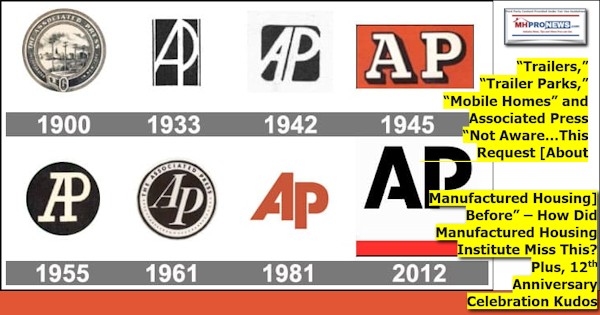
Next up is our business daily recap of yesterday evening’s market report, related left-right headlines, and manufactured housing connected equities.
The Business Daily Manufactured Home Industry Connected Stock Market Updates. Plus, Market Moving Left (CNN) – Right (Newsmax) Headlines Snapshot. While the layout of this daily business report has been evolving over time, several elements of the basic concepts used previously are still the same. For instance. The headlines that follow below can be reviewed at a glance to save time while providing insights across the left-right media divide. Additionally, those headlines often provide clues as to possible ‘market-moving’ news items.
Market Indicator Closing Summaries – Yahoo Finance Closing Tickers on MHProNews…
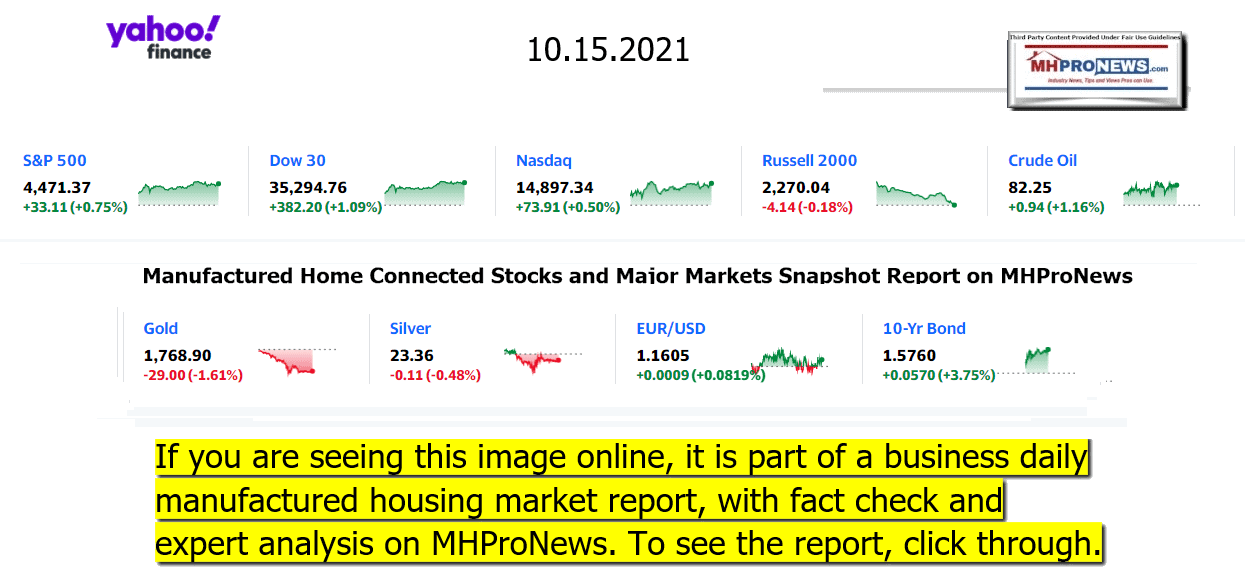
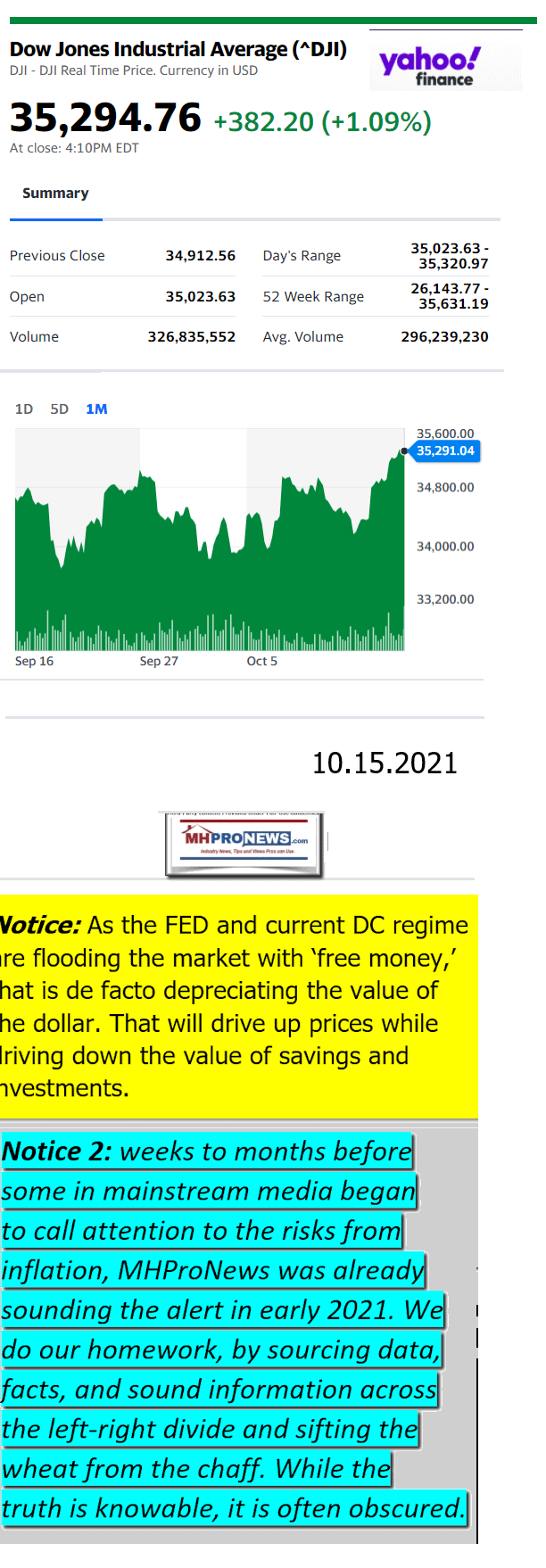
Headlines from left-of-center CNN Business – from the evening of 10.15.2021
- Bitcoin surges
- In this photo illustration, a visual representation of Bitcoin cryptocurrency is pictured on May 30, 2021 in London, England. Bitcoin is a decentralised digital currency, which has been in use since 2009.
- The cryptocurrency tops $60,000 as investors bet on ETF approval
- Goldman Sachs, the Dow’s top stock of 2021, continues to impress
- What big bank earnings tell us about America’s economy
- Shoppers are still spending despite rising prices and supply chain woes
- The reason it’s so easy for wealthy Americans to hide their money — and how to stop it
- The ‘swear word’ at the heart of the great inflation debate
- Mortgage rates climb back above 3%
- RISK TAKERS This world-famous restaurant went vegan, but it’s still charging $335 a person. Will people pay?
- Former Boeing executive indicted for fraud in 737 Max tragedy
- William Shatner says Prince William is ‘missing the point’ of space tourism
- Virgin Galactic stock craters after commercial flights are delayed
- Microsoft’s Jacky Wright had to leave the UK to become its most influential Black person
- Missouri governor threatens legal action against journalist who found flaw that exposed Social Security numbers
- This aerial photo taken on September 17, 2021 shows the halted under-construction Evergrande Cultural Tourism City, a mixed-used residential-retail-entertainment development, in Taicang, Suzhou city, in China’s eastern Jiangsu province.
- ‘Ghost towns’: Evergrande crisis shines a light on China’s millions of empty homes
- WASHINGTON, DC – SEPTEMBER 28: Sen. Elizabeth Warren (D-MA) speaks during a Senate Armed Services Committee hearing on the conclusion of military operations in Afghanistan and plans for future counterterrorism operations at the Dirksen Senate Office building on Capitol Hill on September 28, 2021 in Washington, DC.
- Elizabeth Warren says Amazon is ‘like a monster’ that must be fed every minute
- The glitzy electric Mercedes EQS could be its most important car in decades
- BACK TO OFFICE
- An employee standing at the window looks out over construction sites from the Amazon.com Inc. office campus in Hyderabad, India, on Friday, Sept. 6, 2019.
- Amazon will let individual teams decide how much time they spend in the office
- A ‘Big Four’ firm to allow 40,000 employees to WFH
- Stop making employees turn on webcams
- Google pushes its return to the office back to 2022
- Running hybrid meetings are tough. Here are some tips
- HOLIDAY SEASON
- Dena Fargo’s small stuffed animal.
- Holiday season isn’t bright for Snowcone the Happy Unicorn
- Amazon is starting Black Friday deals early. Like, now
- Halloween Peeps are back after disappearing last year
- This Halloween is going to be a blowout
- Prices are soaring for Christmas trees and decorations
Headlines from right-of-center Newsmax – evening of 10.15.2021
- After Appeals Court Rejection, Biden DOJ to Ask Supreme Court to Halt Texas Abortion Law
- The Biden administration said Friday it will turn next to the U.S. Supreme Court its attempt to halt a Texas law that has banned most abortions since September. The move by the Justice Department comes after an appeals court on Thursday night left in place the law known as Senate Bill 8, which bans abortions once cardiac activity is detected, usually around six weeks. That is before some women know they are pregnant. [Full Story]
- Newsmax TV
- Ex-AG Whitaker: Packing Court Could Harm Its Credibility | video
- Mark Morgan to Newsmax: Numbers of Immigrants This Year Surpass Records | video
- Patterson, Eversmann: Book Spotlights Nurses’ Work, Sacrifice | video
- Ashli Babbitt’s Mother: My Daughter Was Murdered | video
- Scheller Attorney: Challenge Remains on Discharge Classification | video
- Cloud: Biden Admin Doesn’t Want to Stop Immigration Crisis | video
- Jha: Moderna Booster More About Delta Than the Shot | video
- More Newsmax TV
- Newsfront
- Biden Reassures Progressives on Cuts to Spending Bill
- President Joe Biden said Monday that although he expects his social safety net and climate spending package to shrink, “we’re going to come back and get the rest” after it’s passed, a seeming effort to assuage progressives worried their priorities may get cut in the…… [Full Story]
- British Lawmaker Stabbed to Death in Church in Possible Terror Attack
- A lawmaker in British Prime Minister Boris Johnson’s Conservative [Full Story]
- Politico: Pete Buttigieg on Paid Leave Since August After Birth of Children
- Secretary of Transportation Pete Buttigieg’s office reportedly told [Full Story]
- Court Rejects Challenge to Maine Shot Mandate
- A federal appeals court has denied an emergency request to stop a [Full Story]
- Related
- Biden Administration’s Focus on Vaccines Ignores Therapeutics |
- Lawsuit Filed to Challenge New York’s School Mask Mandate
- FDA Panel Endorses Booster Shot for J&J COVID-19 Vaccine
- FDA Delays Decision on Moderna’s COVID-19 Vaccine for Adolescents
- New Mexico Judge Denies Lab Workers’ Claim in Vaccine Fight
- Bill Clinton Recovering From Urological Infection, Aide Says
- Bill Clinton was said to be recovering from a urological infection [Full Story]
- Allen West to Newsmax: Will Keep Rejecting Vaccine Mandates After COVID
- Texas GOP gubernatorial candidate Allen West, even after being [Full Story] | video
- Arizona Sheriff: ‘War on Drugs’ Back Due to Border Crisis
- An Arizona sheriff said Friday the national war on drugs has returned [Full Story]
- Chinese Workers Protest ‘996’ Corporate Culture
- An online campaign for Chinese workers to protest ”996,” which [Full Story]
- Shatner’s Suborbital Shot Heralds New Space Age for Civilians
- William Shatner’s brief Wednesday rocket ride to space – to boldly go [Full Story] | platinum
- Patterson, Eversmann to Newsmax: Book Spotlights Nurses’ Work, Sacrifice
- Bestselling coauthors James Patterson and Matt Eversmann, whose [Full Story] | video
- Ohio Weighs Removing Training Requirements for Concealed Carry
- Both chambers of the Ohio state legislature are weighing laws to lift [Full Story]
- Army Unveils Multi-Year Digital Strategy
- The U.S. Army this week announced the creation of a series of policy [Full Story]
- Scheller Attorney to Newsmax: Challenge Remains on Discharge Classification
- A military judge Friday ordered U.S. Marine Corps Lt. Col. [Full Story] | video
- Capitol Police Officer Indicted for Obstruction After Riot
- A U.S. Capitol Police officer has been indicted on obstruction of [Full Story]
- COVID-Era ‘Great Resignation’ Has Workers Forcing Employers to Pay Up
- The lockdowns and shelter-in-place actions during the COVID-19 [Full Story]
- Poll: Americans Not Impressed With Congress’ Handling of Pandemic
- Americans do not think Congress has done a good job handling the [Full Story]
- Overwhelmed Biden Plans to Reinstate Trump’s ‘Remain in Mexico’ Policy Next Month
- The Biden administration said it plans to reinstate a Trump-era [Full Story]
- McAuliffe Pushes Dems to Turn Out for Virginia Gubernatorial Election
- Former Virginia Gov. Terry McAuliffe, a Democrat, is facing [Full Story]
- Cryptocurrency Boutiques Pop Up Amid Bitcoin Boom
- Cryptocurrency boutiques, or exchanges, like one you would use to [Full Story]
- Number of Workers 65 and Older to Swell to 16M by 2030
- More than 16 million workers 65 and older will be in the labor force [Full Story]
- Russia Says It Pushed US Destroyer From Area Near Its Waters
- Russia’s Defense Ministry says a Russian warship has prevented a U.S. [Full Story]
- Justice Dept. to Ask Supreme Court to Put Texas Abortion Law on Hold
- The U.S. Justice Department on Friday said it will request the U.S. [Full Story]
- Politico Attempts Hit Piece on ‘American Sheriff’ Mark Lamb
- A Politico Magazine feature on the self-described “American Sheriff” [Full Story]
- William Shatner Calls Out Prince William for Dissing Space Exploration
- After taking a trip to space, “Star Trek” actor William Shatner is [Full Story]
- Florida Gov. DeSantis Vows to Fight Biden COVID Vaccine Mandate
- Florida Gov. Ron DeSantis has vowed to fight President Joe Biden’s [Full Story]
- Fully Vaccinated Foreign Visitors Can Enter US From Nov 8
- The United States announced Friday that it will allow entry to [Full Story]
- Blast at Shi’ite Mosque in Afghan City of Kandahar Kills Dozens
- A large explosion tore through a Shi’ite mosque in the southern [Full Story]
- K9 Cadaver Dog Assisting Search for Brian Laundrie
- The search for the boyfriend of the strangled Gabby Petito is now [Full Story]
- Trafalgar Poll: Virginia Race in Dead Heat With Youngkin Edge
- GOP Businessman Glenn Youngkin holds a razor-thin lead over former [Full Story]
- Jha to Newsmax: Moderna Booster More About Delta Than the Shot
- The recommendation from a Food and Drug Administration advisory [Full Story] | video
- Thousands May Have Gotten False Negative COVID Test Results in UK
- British health officials said Friday that an estimated 43,000 people [Full Story]
- More Newsfront
- Finance
- FDA Endorses Lower-Dose Moderna COVID Booster
- FDA Endorses Lower-Dose Moderna COVID Booster
- S. health advisers said Thursday that some Americans who received Moderna’s COVID-19 vaccine should get a half-dose booster to bolster protection against the virus. [Full Story]
- When it Comes to Powell’s Federal Reserve Chairmanship … Questionable Trades Cannot Be Ignored
- Wall Street Banks Set to Profit Again, Even When Fed Withdraws Pandemic Stimulus
- FDA Panel Endorses Booster Shot for J&J COVID-19 Vaccine
- Hedge Funds Place More Bearish Bets as Storm Clouds Darken
- Health
- FDA Panel Endorses Booster Shot for J&J COVID-19 Vaccine
- A panel of U.S. health advisers endorsed booster doses of Johnson & Johnson’s single-shot COVID-19 vaccine Friday, saying they should be offered at least two months after immunization. J&J has asked the Food and Drug Administration for flexibility with its booster, arguing… [Full Story]
- President Clinton’s Sepsis a Reminder for Men to Treat UTI Immediately
- FDA Delays Decision on Moderna’s COVID-19 Vaccine for Adolescents
- Bad News: Americans Are Eating More Ultra-Processed Foods
- FDA’s New Salt Guidelines: 8 Ways You Can Lower Your Intake
Manufactured Housing Industry Investments Connected Equities Closing Tickers
Some of these firms invest in manufactured housing, or are otherwise connected, but may do other forms of investing or business activities too.
-
-
-
-
-
-
-
-
-
-
-
-
- NOTE: The chart below includes the Canadian stock, ECN, which purchased Triad Financial Services, a manufactured home industry lender
- NOTE: Drew changed its name and trading symbol at the end of 2016 to Lippert (LCII).
- NOTE: Deer Valley was largely taken private, say company insiders in a message to MHProNews on 12.15.2020, but there are still some outstanding shares of the stock from the days when it was a publicly traded firm. Thus, there is still periodic activity on DVLY.
-
-
-
-
-
-
-
-
-
-
-
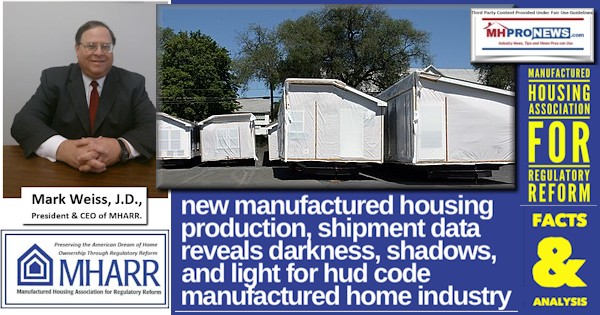
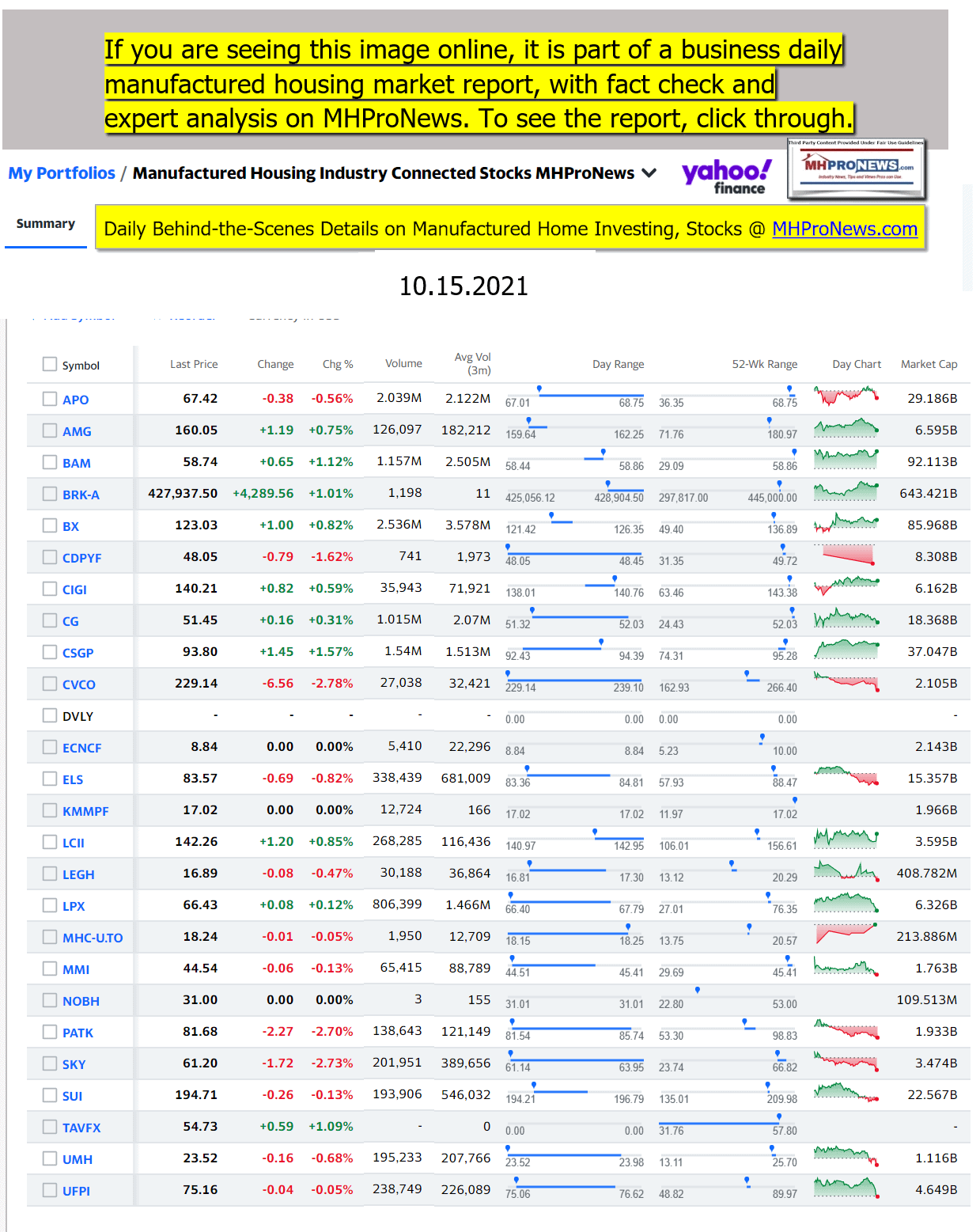
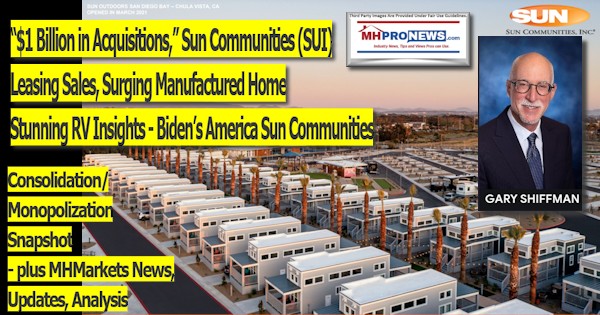

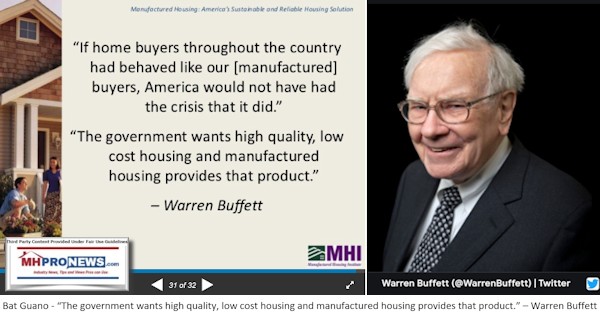


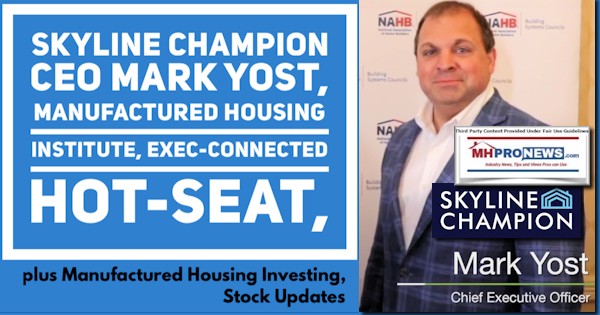
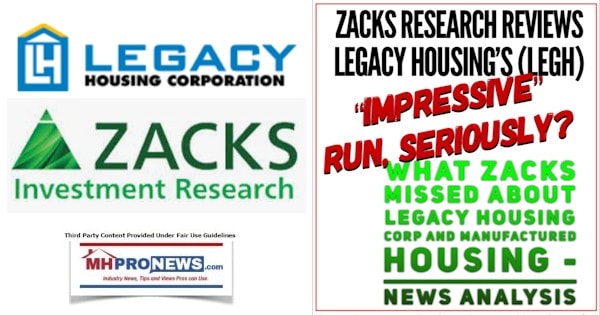
As the Summer of 2021 draws to a close…
Berkshire Hathaway is the parent company to Clayton Homes, 21st Mortgage, Vanderbilt Mortgage and other factory built housing industry suppliers.
· LCI Industries, Patrick, UFPI, and LP each are suppliers to the manufactured housing industry, among others.
· AMG, CG, and TAVFX have investments in manufactured housing related businesses. For insights from third-parties and clients about our publisher, click here.
Enjoy these ‘blast from the past’ comments.
MHProNews. MHProNews – previously a.k.a. MHMSM.com – has celebrated our 11th year of publishing, and is starting our 12th year of serving the industry as the runaway most-read trade media.
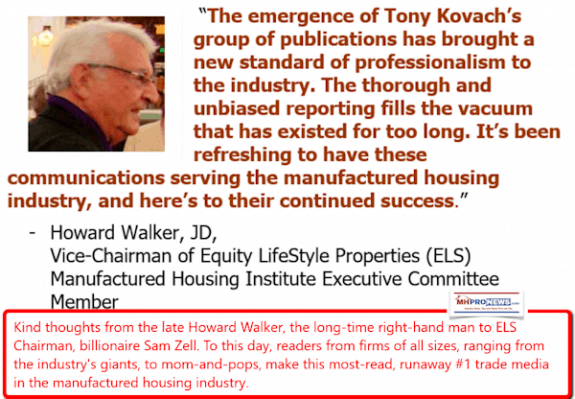
Sample Kudos over the years…
It is now 11+ years and counting…
Learn more about our evolutionary journey as the industry’s leading trade media, at the report linked below.
· For expert manufactured housing business development or other professional services, click here.
· To sign up in seconds for our industry leading emailed headline news updates, click here.
Disclosure. MHProNews holds no positions in the stocks in this report.
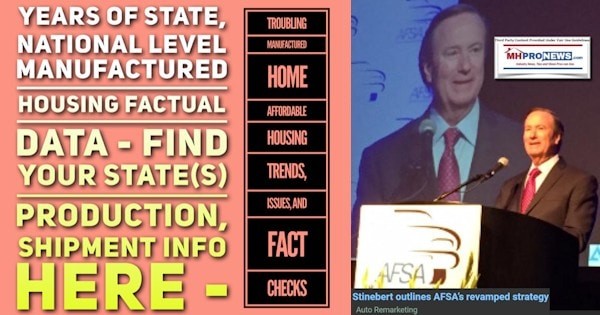



That’s a wrap on this installment of “News Through the Lens of Manufactured Homes and Factory-Built Housing” © where “We Provide, You Decide.” © (Affordable housing, manufactured homes, stock, investing, data, metrics, reports, fact-checks, analysis, and commentary. Third-party images or content are provided under fair use guidelines for media.) (See Related Reports, further below. Text/image boxes often are hot-linked to other reports that can be access by clicking on them.)

By L.A. “Tony” Kovach – for MHProNews.
Tony earned a journalism scholarship along with numerous awards in history. There have been several awards and honors and also recognition in manufactured housing. For example, he earned the prestigious Lottinville Award in history from the University of Oklahoma, where he studied history and business management. He’s a managing member and co-founder of LifeStyle Factory Homes, LLC, the parent company to MHProNews, and MHLivingNews.com. This article reflects the LLC’s and/or the writer’s position, and may or may not reflect the views of sponsors or supporters.



